Installation Art – Exploring the Multisensory Art World
Any lover of Contemporary art is sure to come across the term “installation art”. Installation art has grown immensely popular over the last few decades and has become an important focus for artists, art institutions, and art collections. While some find understanding installation art challenging, others have enjoyed its immersive and participatory approach. But, what is installation art, and what are the most famous installation art examples? This article will introduce you to all you need to know about the magical art form of installation, including a few key installation art examples that will leave you with a newfound appreciation of the art form.
What Is Installation Art?
Installation art is a term mostly used to describe artworks that are made “in situ”. This means that the work is created or installed within the specific space where it is meant to be viewed. For this reason, Installation art is sometimes also called “environments” and it is often comprised of large-scale multi-media assemblages, sculptures, and other media, which are curated to provide an immersive experience.
Installations often occupy an entire room or gallery space and requires the viewer to engage with the works of art by interacting with the different media and navigating their relationships with space.
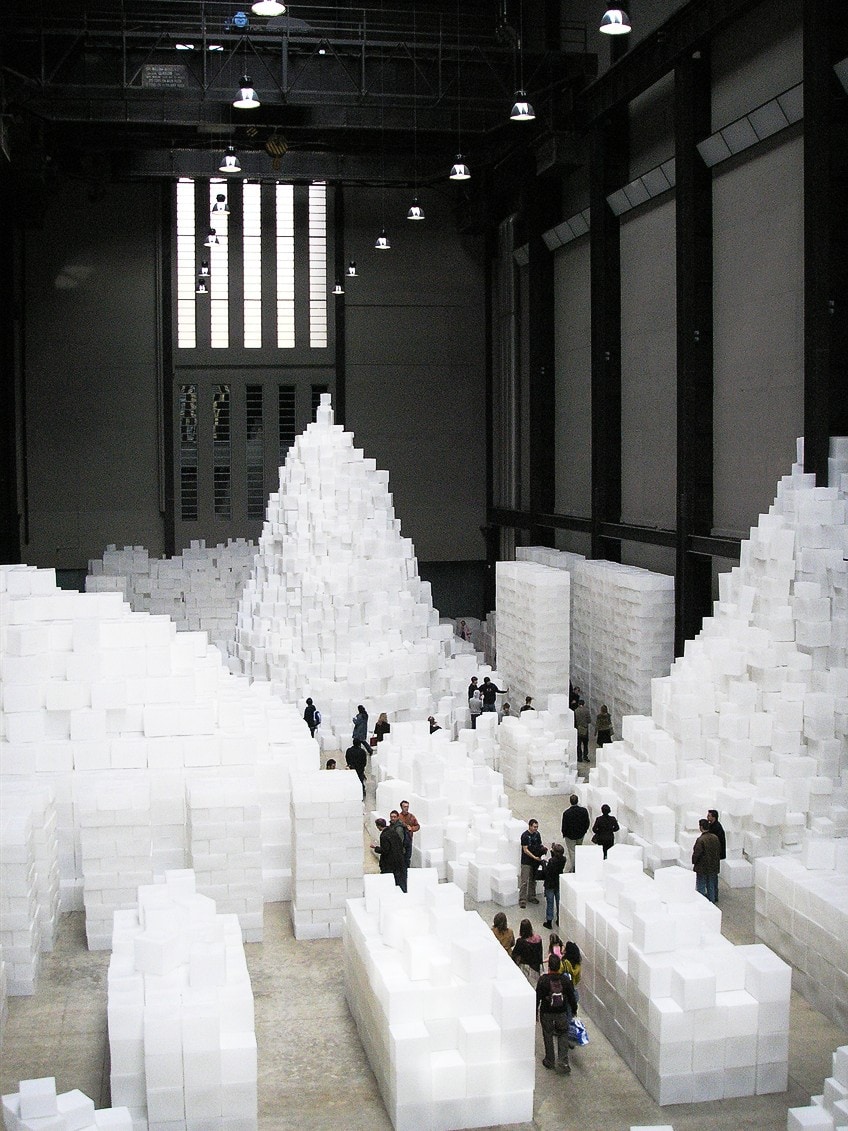
Although these are some common qualities of installation art, the boundaries of what is considered installation art have been blurred since the introduction of the genre. Below, we will dive into some of the major characteristics of installation art, such that by the end of this article, you can be confident in identifying what an installation artwork is.
Reviewing Installation Art Characteristics
Installation art is a versatile art form that encompasses a myriad of different approaches, mediums, and possibilities. Installation artworks, at times, can be either simple or multifaceted in design and concept. Installation in art can also be constructed in any space, be it a gallery space, the outdoors, or even the digital world.
In installation art, the work of art presented relies on the viewer’s participation and is often set up as a temporary experience to evoke concepts related to the site of exhibition and the artist’s occupation of the space.
Installation artists such as Yayoi Kusama and Damien Hirst have leveraged installation alongside sculpture to create works that not only carried shock value, but also left a resounding impact on the way we understand and interpret installation works. Below, we will dive further into the different characteristics of installation art, which will help you understand how impactful this art form can be!
Installation Art Is Often Designed to Be Immersive
Installation art varies widely but generally, it is focused on the viewer’s experience of the work. Installation artworks often aim to transform the viewer’s perception of space, making them deeply immersive.
Whilst some installation artworks are silent, others are interactive and require the audience’s participation and engagement to achieve an impact and be interpreted.
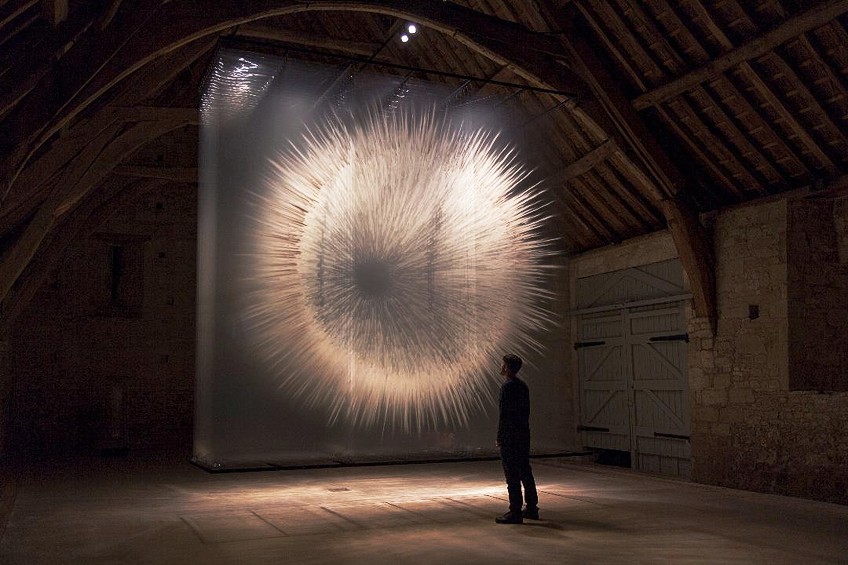
The immersive experience is so important to many installation artists that they aim to heighten the viewer’s experience by the addition of sound, smell, and touch. By engaging the viewer’s senses, the installation artwork often becomes a whole new environment that viewers can experience.
It Is an Art Genre Popular with Postmodern Artists
Installation art was incredibly popular among postmodern artists but it is not necessarily only postmodern artists who create installation artworks, nor do all postmodern artists focus solely on installation art. Installation art developed alongside conceptual art and are both recognized as the two most important art genres of postmodern art.
Postmodern artists are known for pushing the boundaries of what is considered to be “art objects” and they often pushed these boundaries as far as they could.
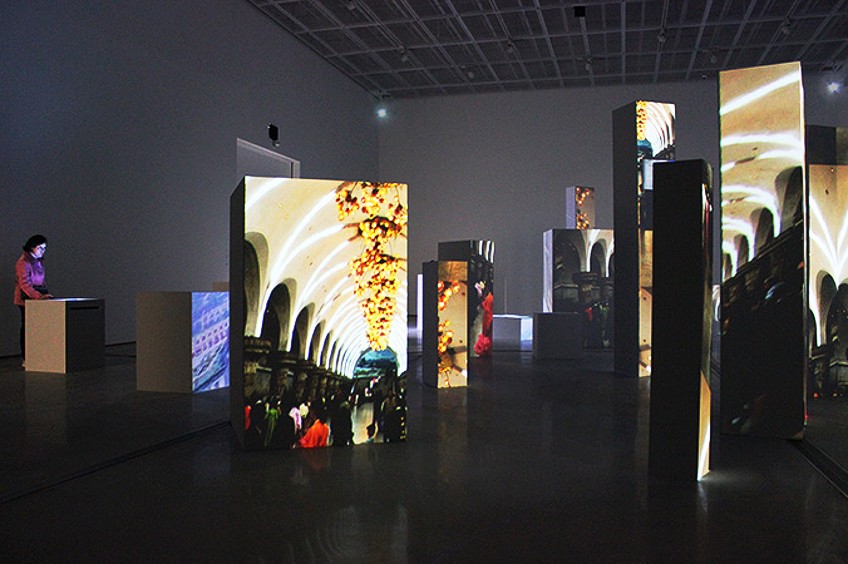
Installation art emerged from this shifting of boundaries, where artists wanted to make work that was not admired from a distance (as in the case of a painting or sculpture) but rather experienced from inside of the work itself. In conceptual art, the most important aspect of an artwork was the “idea” behind it and its impact on the viewer.
Installation artists are not only concentrated on the concept of the artwork but are also concerned with the material aspects of the installation, including how those materials interact with the space and each other.
While “pure” conceptual art is not concerned with the materials used in the art or its “end product”, installation art is much more focused on which materials are used to present the idea. In this way, installation is more “grounded” than conceptual art since it remains tied to materials and physical spaces.
The Longevity of Installation Art Varies
Installation art can be made either to be temporary or permanent. This often depends on the space used, for whom the installation was created, and the kind of materials and objects used to make the installation.
Some materials used in art installations can sometimes be temporary, for example, plants, which can deteriorate, dry out, and die.
Other installation works can be site-specific and thus have to be taken down for a space to function as normal after the installation has run its course. In these cases, the only way that the installation work can live on is in the documentation of the work, that is, in photographs or videos.
In some cases, museums or collectors might commission an artist to create an installation work within their space to exist within the space permanently.
Installation Art Utilizes Many Different Materials
With its goal of immersion, installation in art can take on many different forms and use a myriad of different materials. One can imagine the kind of materials that artists might use to evoke certain sounds, smells, touches, or even tastes. Installation art can thus utilize a wide range of materials, including the more traditional ones like painting, sculpture, or photography, but it can also use unusual mediums such as light, electronics or projections, dance, and sound, or even tea leaves, grass, and dirt.
There is no limitation on which materials can be used in installation art.
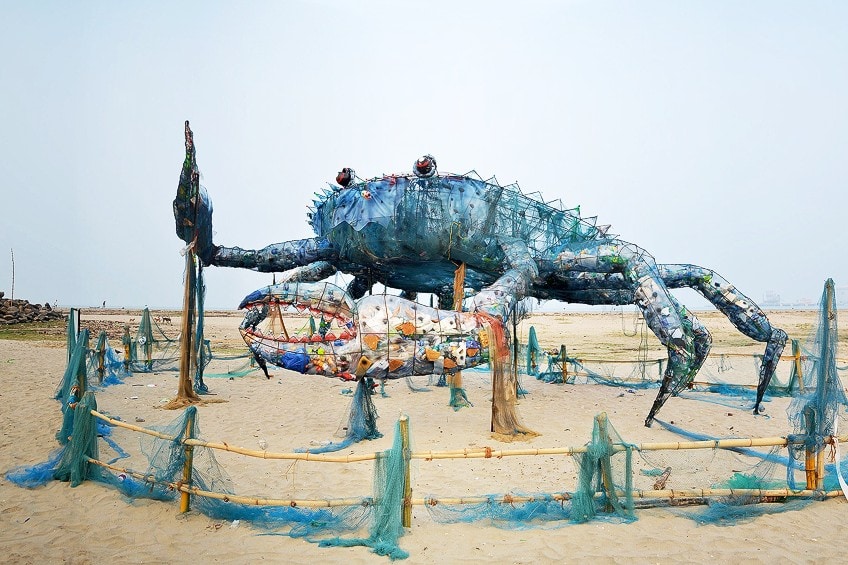
How Did Installation Art Develop?
Installation art started to emerge during the early 1960s and developed alongside conceptual art. Installation art can be traced back to the works of Marcel Duchamp (1887-1968), who introduced the notion of a readymade objects into a gallery space as a sculpture. The found urinal, called Fountain (1917), challenged the definition of art, as it was widely understood back then.
Installation art was thus hugely inspired by Dadaism and the Avant-Garde artists of the time.
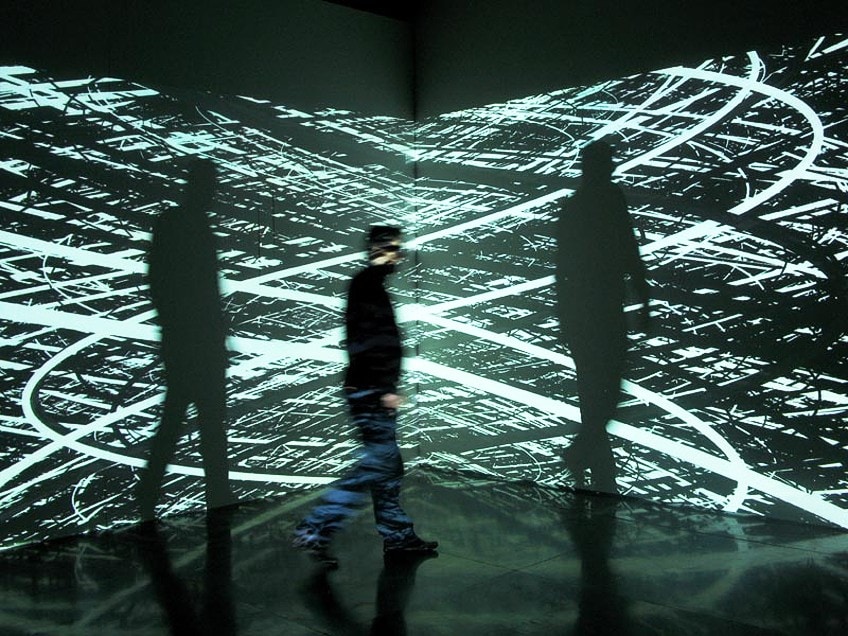
A few key figures in installation art include Kurt Schwitters (1887-1948), El Lissitzky (1890-1941), Lucio Fontana (1899-1968), and Allan Kaprow (1927-2006). These artists, alongside Contemporary figures like Judy Chicago (1939-present), Ai Weiwei (1957-present), Doris Salcedo (1958-present), and Damien Hirst (1965-present), have skillfully leveraged space and the relationships of viewers to artworks to their advantage. As installation evolved into the 21st century, it had also begun to adopt art forms like performance art and video art to enhance the experience of art and offer a layered dimension to installation concepts.
Famous Installation Art Examples You Should Know
Installation art is a very exciting art genre to explore and below are some of the most recognizable and memorable Installation art examples ever made. This section will look at ten artists you should know that made unique contributions to the genre of Installation art. One prominent work of each artist will be discussed to help us define what is Installation art.
Yard (1961) by Allan Kaprow
| Artist | Allan Kaprow (1927 – 2006) |
| Date | 1961 |
| Medium | Installation of black rubber tires |
| Where It Is Housed | Outside of the Martha Jackson Gallery, New York City, United States |
Allan Kaprow was considered to be one of the first installation artists, whose work on Yard (1961) established a turning point in art history. In this work, the artist utilized the backyard of the Martha Jackson Gallery in New York and completely filled it with black rubber tires.
The artist invited participants to explore the transformed backyard, which resulted in many people climbing and jumping on the tires as if the installation was a giant playground.
This magical work stimulated visitors’ interaction with the installation in a playful way that was not often seen at the time, especially in an art context. Kaprow believed that by making viewers active participants in art, rather than mere spectators, art could become much closer to life.
In this way, Kaprow managed to blur the lines between art and life, which he believed made it all so much more interesting.
The End of the Twentieth Century (1983 – 1985) by Joseph Beuys
| Artist | Joseph Beuys (1921 – 1986) |
| Date | 1983-1985 |
| Medium | Installation of basalt rock with felt and clay |
| Where It Is Housed | Tate Gallery, London, United Kingdom |
German sculptor Joseph Beuys might be one of the most famous 20th-century artists. Beuys made The End of the Twentieth Century, only a year before his death, making it one of the last works ever created by this monumental artist. The installation consists of 31 large basalt rock slabs, arranged haphazardly across the floor of the gallery space.
Each basalt rock slab was unique with its own weight, character, and history.
In each of the pieces, the artist drilled a cylindrical hole, which he filed with a mixture of felt and clay, and then polished them down so that it was hardly recognizable in the rock. Beuys’ artistic intervention in this work was subtle, leaving only a gentle trace that he had a hand in the visual outcome of each basalt rock.
With this subtle intervention, made at the turn of the century, Beuys wanted to reference the weight of history that was passed onto the new era.
Cold Dark Matter: An Exploded View (1991) by Cornelia Parker
| Artist | Cornelia Parker (1956 – Present) |
| Date | 1991 |
| Medium | Installation of an exploded shed |
| Where It Is Housed | Tate Gallery, London, United Kingdom |
Cornelia Parker is a renowned British installation artist, who is best known for her 1991 work titled Cold Dark Matter: An Exploded View. Her installation was visually striking and utterly memorable, mimicking a shed mid-explosion. To create this work, Parker blew up an actual shed, filled with all sorts of domestic objects, tools, and toys.
However, she did not blow up the shed herself but rather asked the British Army to bomb it for her in a field.
She then recreated the explosion scene in the gallery space, bringing together all the fragments and suspending them in mid-air. Eerie lighting cast onto the installation made the once familiar object become abstract shadow shapes, and with the title Cold Dark Matter, Parker seems to be drawing parallels with dark matter in the universe and the explosion that both destroyed and created life.
The End of Uncle Tom and the Grand Allegorical Tableau of Eva in Heaven (1995) by Kara Walker
| Artist | Kara Walker (1969 – Present) |
| Date | 1995 |
| Medium | Installation of black silhouettes |
| Where It Is Housed | Brooklyn Museum, New York City, United States |
American artist Kara Walker is best known for her monumental theatrical monochrome silhouettes. Her work often addresses the problematic racial history of America and touches on themes such as race, sexuality, gender, identity, and violence. Her work has a strong narrative quality, which can be seen in her often-lengthy titles.
Her works are inspired by historical events, similar to how history paintings were used to commemorate notable events such as war victories.
Unlike these historical paintings, Walker’s silhouettes are ambiguous and the event depicted is often unclear. Playing out scenes against the walls of the gallery, Walker’s silhouettes perform narratives of violence in a way that still allows for audience interpretation.
Walker deliberately creates this ambiguity and argues that the generalization of her silhouettes resemble how African-Americans in the United States continue to be stereotyped, which is something she wishes to unveil.
My Bed (1998) by Tracey Emin
| Artist | Tracey Emin (1963 – Present) |
| Date | 1998 |
| Medium | Found Happening |
| Where It Is Housed | Tate Gallery, London, United Kingdom |
Tracey Emin’s controversial art installation My Bed changed the course of installation art when it was first exhibited in 1998. Emin’s art installation took the form of a literal visual autobiography. In this work, which has inspired equal amounts of critique and praise throughout the years, Emin displayed her own bed after spending four days in a depressed state, in the bed.
The bed was displayed in a messy state of occupation and was covered in used condoms, blood-stained underwear, and empty bottles.
The installation is blatantly realistic as it gives a visual snapshot of the artist’s life in a time of crisis. Whilst some described the work as delusional, narcissistic, and self-absorbed, others saw it as a seminal work that was powerful and authentic due to its unapologetic Realism.
Critics, however, agreed that the work brought an intimacy into the gallery space that was undeniable.
Work No. 227: The lights going on and off (2000) by Martin Creed
| Artist | Martin Creed (1968 – Present) |
| Date | 2000 |
| Medium | Installation of an empty room with a light |
| Where It Is Housed | Tate Gallery, London, United Kingdom |
Martin Creed’s Work No. 227: The lights going on and off is possibly one of the simplest and most minimal pieces of installation art of all time. Creed’s installation consisted of an empty room that lit up in recurring periods of five seconds on and five seconds off.
This incredibly subtle work had many people wondering how it can be considered art at all. In all its simplicity, it was an artwork that got people talking and grabbed the attention of audiences.
What was the work about? Work No. 227: The lights going on and off was a conceptual installation artwork that used the illumination of a room as a way to make viewers reconsider the things we take for granted in our everyday lives.
This minimalist installation plays with viewers’ expectations by leveraging the confusion of the viewer to leave “room for thought”.
The aim was to shift the viewer’s preconceived expectations to allow them to gain new perspectives. Through the complete simplicity and mundanity of the work, Creed forced the viewer to interact differently with this seemingly static room.
The Dinner Party (2002) by Judy Chicago
| Artist | Judy Chicago (1939 – Present) |
| Date | 2002 |
| Medium | Installation of a triangular dining table with thirty-nine place settings |
| Where It Is Housed | Brooklyn Museum, New York City, United States |
Judy Chicago is an iconic feminist artist and writer. Her installation artwork The Dinner Party (2002) has become a monument to women’s history. The work consists of a large triangular ceremonial banquet table, seating 39 guests, all women of honor, either historically or mythically.
The table is adorned with embroidered runners, golden utensils, and porcelain plates that proudly resemble the female vulva, and each guest has a unique design that symbolizes them.
The table has 39 place settings that each honor an important woman, either historically or mythically. Each table setting is personalized and the guests include female artists, activists, academics, and even goddesses. On the floor, beneath the table, are 999 other female names, inscribed with gold on a white tile. In this installation, viewers are invited to walk around the table, inspecting the names of the guests to be honored.
The artists chose names of women who had been under-represented in history and through the audience viewing the work, the artwork became the event of the dinner party itself.
The Weather Project (2003) by Olafur Eliasson
| Artist | Olafur Eliasson (1967 – Present) |
| Date | 2003 |
| Medium | Installation of mirrors, light, and mist |
| Where It Is Housed | Tate Modern Turbine Hall, Berlin, Germany |
In this incredibly immersive and surreal installation, Danish-Icelandic installation artist Olafur Eliasson changed the weather conditions within the Tate Modern’s Turbine Hall. In this ambitious work, Eliasson transformed the space by creating the effect of a massive sun glowing through fine mist hanging in the space.
The golden glow of the artificial sun was made with low-frequency lamps that dominated the space, giving everything around it a magical illumination of black and gold.
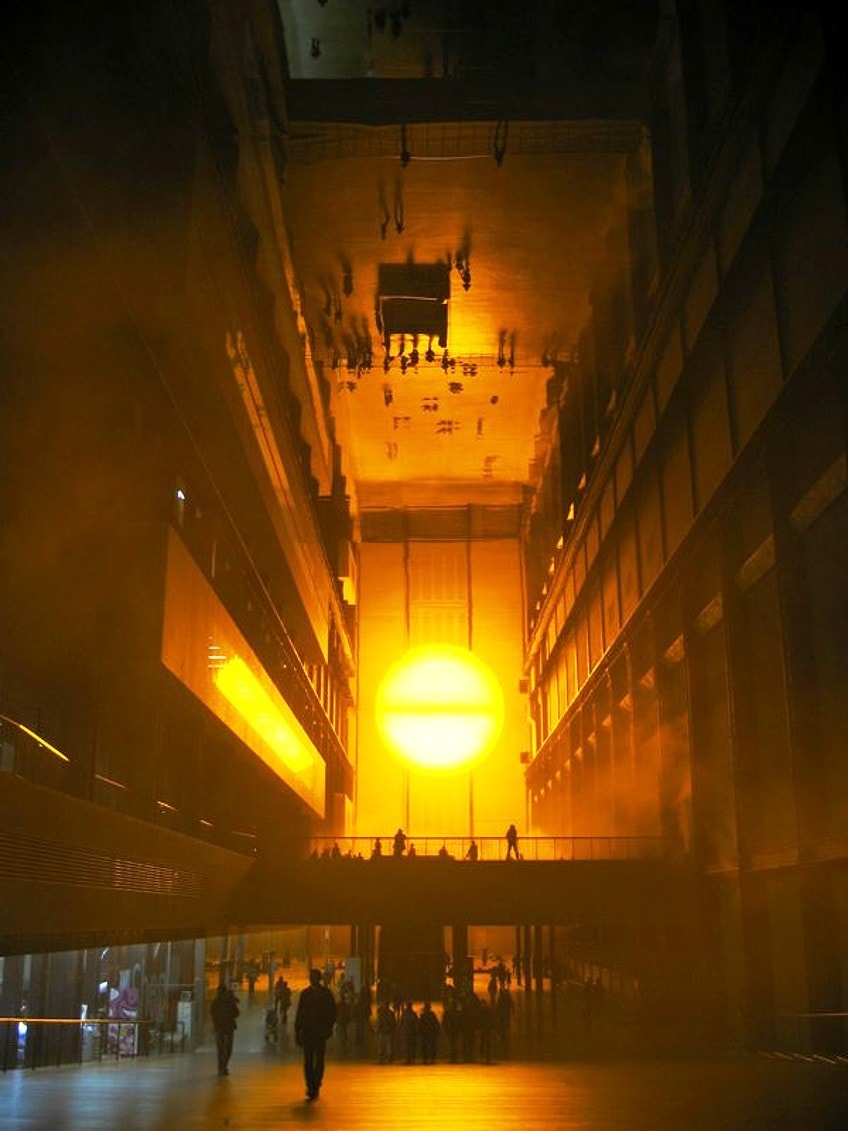
The low-frequency lamps are assembled in a half-circle that glows against the top of the wall, meeting the ceiling. The half-circle reflects onto the ceiling, which the artist had covered in mirrors, completing the full circle shape of a sun. The mirrored ceiling also reflects the viewers’ shapes, and many of them lied down on the ground to see themselves floating in the glowing orange sky above.
Eliasson is an artist described to be a master of illusion, using the science of light to orchestrate his marvelous and immersive creations.
You (2007) by Urs Fischer
| Artist | Urs Fischer (1973 – Present) |
| Date | 2007 |
| Medium | Installation of a crater in the gallery floor |
| Where It Is Housed | Gavin Brown’s Enterprise, New York City, United States |
Urs Fischer’s installation titled You (2007) is an artwork that was based on removal rather than addition. In this work, Fischer transformed a gallery space in New York City by destroying its concrete floor. By tearing out the floor, Fischer created a void that he filled with dirt.
This massive dirt crater created by the artist was over two meters deep and stretched to all corners of the white-walled gallery space, measuring approximately nine by eleven meters.
Viewers described the experience of the work as “thrilling”, as they stood at the edges of the hole, peering into the natural-looking landscape created within the gallery. The work critically engages with questions surrounding the role of the traditional gallery space and the kind of art that is deemed worthy to exhibit in such a space.
Infinity Mirrored Room – The Souls of Millions of Light Years Away (2013) by Yayoi Kusama
| Artist | Yayoi Kusama (1929 – Present) |
| Date | 2013 |
| Medium | Installation of mirrored panels and colored lights |
| Where It Is Housed | The Art Gallery of Ontario, Toronto, Canada |
Japanese installation artist Yayoi Kusama is one of the most interesting and iconic installation artists of our time. Kusama’s famous infinity rooms have captured the imagination of audiences since 1965 with her masterpiece Infinity Mirror Room – Phalli’s Field. In this work, Kusama used mirrors to elevate the effect of her earlier textile works of polka-dotted phallic fabric shapes.
Since the success of this work, Kusama continued to make over 20 additional “Infinity Rooms”, all differing in size, medium, and levels of audience engagement.
Her installation Infinity Mirrored Room – The Souls of Millions of Light Years Away (2013) is just one of numerous immersive infinity rooms that have become immensely popular among viewers from all over the world. This specific installation was made by covering all the walls, ceiling, and floors with mirrors.
The artist then had a network of tiny colored lights projected in different directions over the otherwise completely dark room.
As a result, the entire space became an infinity of lights, refracting on all the mirrored surfaces and multiplying into infinity. The visual effect of the installation is so strong that the viewer feels immersed in an endless space, as if standing among the stars. Furthermore, the viewer’s experience is made even more surreal as one can also see their reflection scattered all around the room.
Book Recommendations
Installation art is an immensely rich genre of art, full of fabulous works that are immersive and expansive. The book recommendations below introduce its readers to the exciting world of installation art. All these books are sure to expand our ideas about what art is and what art can be!
Installation Art (2011) by Claire Bishop
Installation art by Claire Bishop is one of the most comprehensive publications on Contemporary installation art to date. In this book, Bishop provides both a history of the genre and a critical examination of the genre from 1950 until 2011. The book utilizes and unpacks the most exciting case studies that installation art in this period has to offer. This beautifully illustrated book will unpack acclaimed installation artworks, whilst also introducing the reader to various emerging artists.
This best-selling publication is a fantastic buy for anyone seeking a complete collection of some of the most intriguing installation artworks from different countries and biennales. This striking collection features pink balloons suspended in a major city site in addition to light rays that hover in space, which will have you in awe of the magical qualities of installation art.
Unexpected Art: Serendipitous Installations, Site-Specific Works, and Surprising Interventions (2015) by Jenny Moussa Spring
This book is a fabulous publication full of wonder and curiosities, from icing graffiti to man-made clouds. This collection of over 50 innovative installation artists is sure to amaze and inspire any fan of installation art. The works featured in this book focus on unique site-specific installations that are full of experimentation and ingenuity. The book, with its unusual design of different colored pages, will also make a stunning gift for any art lover.
Installation art is a very unique genre of art that prioritizes the spatial experience of the viewer. Artists all over the world continue to push the boundaries of what can be achieved through installation, making it one of the most exciting and dynamic art forms of our time. One of the latest developments in installation art is the incorporation of virtual and augmented reality, which many have embraced to create unforgettable works of art!
Take a look at our art installations webstory here!
Frequently Asked Questions
How Should One Interact With Installation Art?
How a viewer interacts with installation artworks will depend on each work. Often, viewers are expected to walk through the installation to fully appreciate and engage with it. Some installations might be too fragile to allow the viewer to walk through them and requires the viewer to either walk around them or look into them from a window or doorway. Other works might require the viewer to physically participate in the work to make it come alive. When visiting art installations, most artists or institutions will be able to explain to the viewer how best to engage with each different work.
Do Artists Still Make Installation Art?
Installation art remains one of the most dominant art forms that Contemporary artists choose to use. The art form continues to grow and transform with the advancement of technology, for example, virtual reality. In this way, installation art continues to re-invent and update itself, and thus remains relevant.
What Happens to Installation Artworks After They Are Exhibited?
An installation artwork is created around the main focus of the experience and not on its value as a commodity. Beyond this, not all materials used in installations are chosen for their permanence. In these cases, the installation will simply be taken down after it was exhibited and photographs or films of the installation will be the only way for the artwork to live on. There are, however, instances where installation works are bought by a collector or institution. In this case, the work will most likely be dismantled by the artist and re-assembled in a new space chosen by the buyer. In other scenarios, the artist might give installation instructions to the buyer on how the work must be installed, should it be included in a future exhibition.
Chrisél Attewell (b. 1994) is a multidisciplinary artist from South Africa. Her work is research-driven and experimental. Inspired by current socio-ecological concerns, Attewell’s work explores the nuances in people’s connection to the Earth, to other species, and to each other. She works with various mediums, including installation, sculpture, photography, and painting, and prefers natural materials, such as hemp canvas, oil paint, glass, clay, and stone.
She received her BAFA (Fine Arts, Cum Laude) from the University of Pretoria in 2016 and is currently pursuing her MA in Visual Arts at the University of Johannesburg. Her work has been represented locally and internationally in numerous exhibitions, residencies, and art fairs. Attewell was selected as a Sasol New Signatures finalist (2016, 2017) and a Top 100 finalist for the ABSA L’Atelier (2018). Attewell was selected as a 2018 recipient of the Young Female Residency Award, founded by Benon Lutaaya.
Her work was showcased at the 2019 and 2022 Contemporary Istanbul with Berman Contemporary and her latest solo exhibition, titled Sociogenesis: Resilience under Fire, curated by Els van Mourik, was exhibited in 2020 at Berman Contemporary in Johannesburg. Attewell also exhibited at the main section of the 2022 Investec Cape Town Art Fair.
Learn more about Chrisél Attwell and the Art in Context Team.
Cite this Article
Chrisél, Attewell, “Installation Art – Exploring the Multisensory Art World.” Art in Context. August 19, 2022. URL: https://artincontext.org/installation-art/
Attewell, C. (2022, 19 August). Installation Art – Exploring the Multisensory Art World. Art in Context. https://artincontext.org/installation-art/
Attewell, Chrisél. “Installation Art – Exploring the Multisensory Art World.” Art in Context, August 19, 2022. https://artincontext.org/installation-art/.




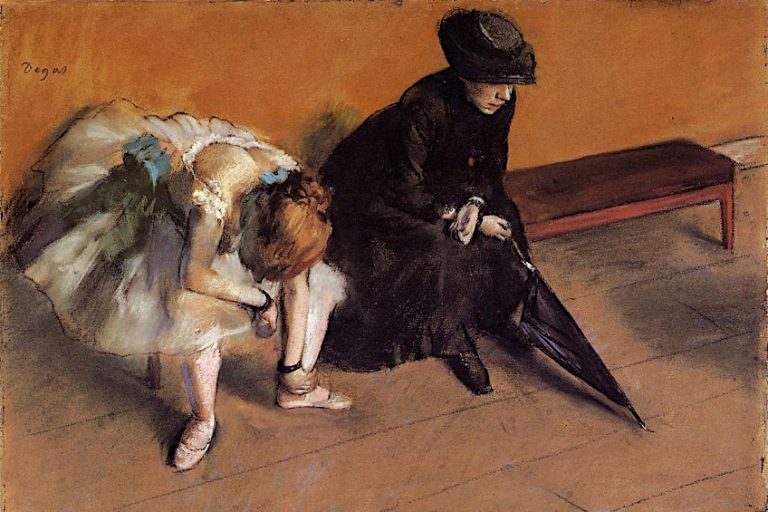

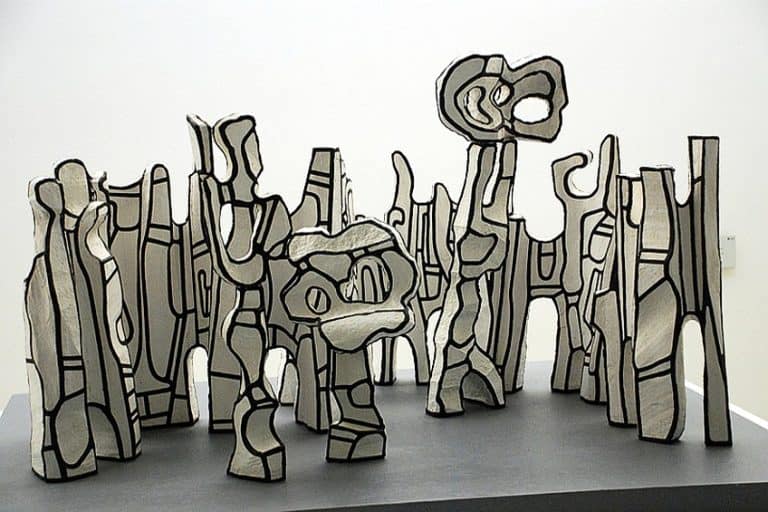
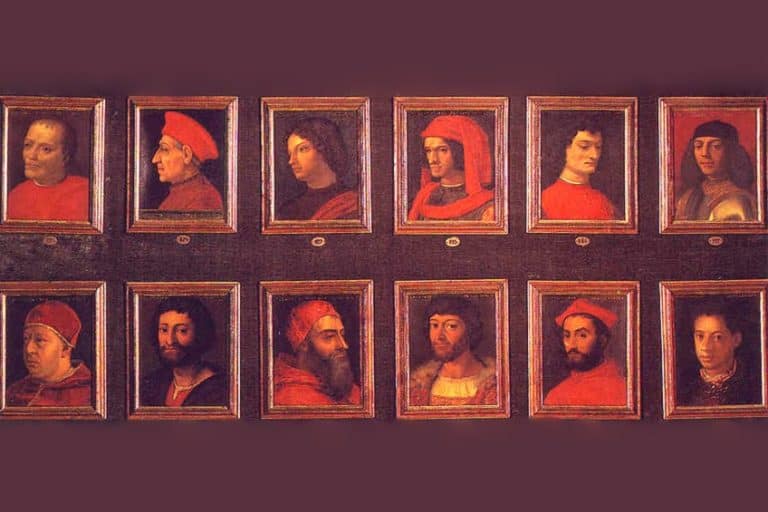



Thank you for sharing some much needed information